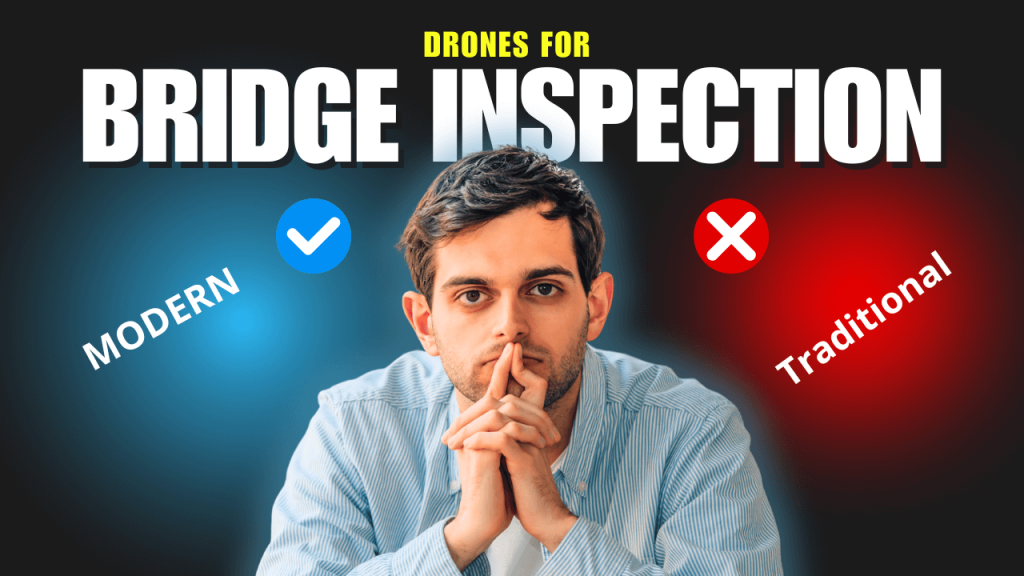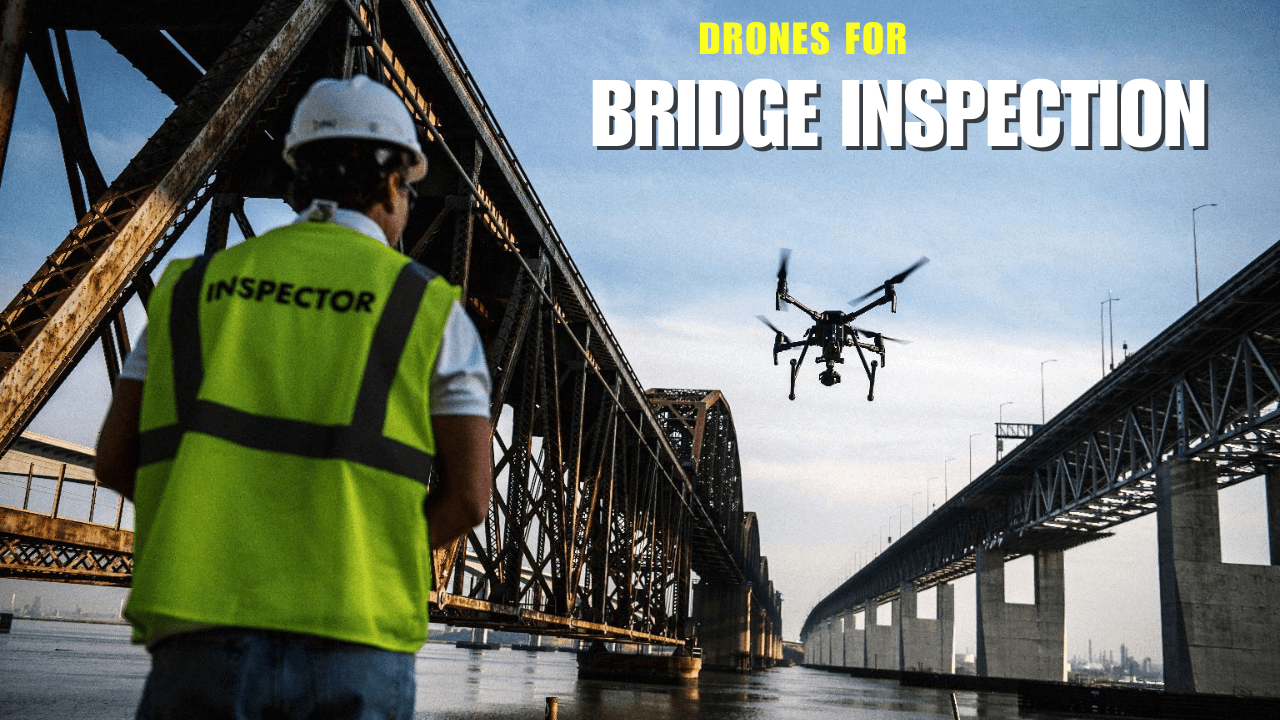Drones for bridge inspections are crucial for maintaining infrastructure safety and longevity. As technology advances, the debate between drone-based and traditional inspection methods has intensified. This article explores the question: “Drone vs. Traditional Methods: Which is Better for Bridge Inspections?” We’ll delve into the pros and cons of each approach, helping you understand the evolving landscape of bridge inspection techniques. Drones for bridge inspections have been used in mapping and surveying for a long time now.
The integration of drones into the infrastructure inspection process represents a significant shift in how we approach maintenance and safety. With their ability to cover large areas quickly and efficiently, drones are becoming a vital tool in the arsenal of engineers and maintenance crews. The precision and detail that drones provide can lead to early detection of issues that might otherwise go unnoticed, ultimately saving time and resources.
The rise of drones for bridge inspections is revolutionizing how we look at infrastructure maintenance. Utilizing drones for bridge inspections provides an efficient, safe, and thorough approach that surpasses traditional techniques.
Furthermore, incorporating drones for bridge inspections can lead to improved data collection, allowing engineers to make more informed decisions regarding maintenance and safety.
With the increasing use of drones for bridge inspections, regulatory compliance and pilot training are becoming essential components of effective inspection strategies.
In the ongoing evolution of bridge inspections, drones for bridge inspections can help mitigate risks associated with traditional methods while enhancing overall inspection quality.
In addition, the ability of drones for bridge inspections to capture high-quality images can significantly improve the accuracy of assessments.
Moreover, drones for bridge inspections can be utilized in various environments, making them versatile tools for engineers.
Traditional methods, while effective, can be limited in scope. Engineers often rely on a combination of visual inspections and specialized equipment, but these methods can be labor-intensive and time-consuming. For instance, inspecting a large bridge might take several days, which can be further complicated by factors such as weather and traffic. In contrast, drones can quickly map the entire structure, providing real-time data that can inform maintenance decisions.
Traditional Bridge Inspection Methods
By employing drones for bridge inspections, engineers can enhance their ability to identify structural defects early on, ensuring long-term safety.
Utilizing advanced drones for bridge inspections can lead to faster reporting, which is crucial for timely decision-making.
Visual Inspections
Traditional bridge inspections primarily rely on visual assessments conducted by trained engineers. These inspections involve:
Specialized equipment like drones can easily reach areas that are difficult to access. For example, underbelly inspections of bridges can be challenging and dangerous for human inspectors. Drones equipped with high-resolution cameras can capture images from angles that would otherwise pose risks, ensuring thorough examinations of structural integrity.
- Walking the entire length of the bridge
- Examining structural elements up close
- Using basic tools like binoculars and measuring devices
Specialized Equipment
Non-destructive testing methods are essential in evaluating the condition of materials without causing damage. However, these tests often require extensive setup and manual labor. By incorporating drone technology with NDT methods, inspectors can perform scans from a safe distance, while still obtaining crucial information about the bridge’s health.
When comparing inspection methods, including drones for bridge inspections in the conversation highlights the shift towards modernization.
For hard-to-reach areas, traditional methods employ:
- Bucket trucks or cherry pickers
- Scaffolding
- Rope access techniques
Non-Destructive Testing (NDT)
The evolution of drone technology has led to the development of specialized drones tailored for specific inspection tasks. For instance, some drones are designed to carry payloads for NDT equipment, combining high-tech imaging with advanced testing capabilities. This fusion of technologies signifies a future where bridge inspections can be completed more efficiently and safely than ever before.
Advanced traditional methods may include:
- Ultrasonic testing
- Ground-penetrating radar
- Magnetic particle testing
Bridges are essential for connectivity, and drones for bridge inspections ensure they remain safe and functional.
Drone-Based Bridge Inspections

By making the case for drones for bridge inspections, we can encourage wider adoption of these technologies across the industry.
Ultimately, the integration of drones for bridge inspections within standard practices will continue to evolve.
How are drones used for inspection?
Drones, or Unmanned Aerial Vehicles (UAVs), offer a new approach to bridge inspections:
- High-resolution imaging
- Real-time video feeds
- Thermal imaging for detecting hidden issues
- LiDAR scanning for 3D modeling
When comparing the safety of traditional methods and drone inspections, it’s clear that drones significantly reduce the risk of accidents. For instance, inspecting bridges over busy highways can be perilous for human inspectors. Drones eliminate the need for personnel to be exposed to such hazardous environments, allowing for safer inspection processes.
Efficiency is another critical factor in bridge inspections. Drones can be deployed rapidly and have the capability to collect data much quicker than traditional methods. For instance, a drone can complete a full inspection of a bridge in a matter of hours, while traditional inspections may span multiple days. This not only saves time but also minimizes disruption to traffic and the surrounding area.
Which drone is recommended for completing inspections?
Several drones are suitable for bridge inspections, including:
- DJI Matrice 300 RTK
- Flyability Elios 2
- Skydio X2
The choice depends on specific inspection requirements and bridge characteristics.
Comparing Drones and Traditional Methods
Safety
Traditional Methods:
- Risk of falls and accidents for inspectors
- Exposure to traffic and environmental hazards
As more engineers turn to drones for bridge inspections, we can expect to see enhanced standards and safety protocols.
The use of drones for bridge inspections will also drive advancements in technology, further improving the inspection process.
Drone-Based Inspections:
Cost analysis is also important when deciding on inspection methods. Although initial investments in drone technology can be high, the long-term savings can be substantial. The reduced need for heavy equipment and fewer labor hours can lead to significant cost reductions over time, making drones a financially viable option for many organizations.
- Reduced risk to human inspectors
- Ability to inspect dangerous or inaccessible areas safely
Efficiency
Traditional Methods:
- Time-consuming setup (scaffolding, traffic control)
- Limited by weather conditions and daylight hours
Data collection is a fundamental aspect of both inspection methods. Drones have the advantage of capturing vast amounts of data in high-resolution formats, making it easier for engineers to analyze and store information. For example, the ability to create 3D models of bridges allows for more in-depth assessments and can aid in future maintenance planning.
Drone-Based Inspections:
- Rapid deployment and data collection
- Less disruption to traffic flow
- Ability to inspect multiple bridges in a day
As we progress, the advantages of using drones for bridge inspections will become increasingly clear to stakeholders.
Cost
Traditional Methods:
While drones are a remarkable advancement, they are not without limitations. Battery life constraints can affect the duration of inspections, especially for larger structures. Moreover, adverse weather can hinder drone operations. Engineers must consider these factors when planning inspections to ensure efficiency and safety.
Traditional methods also have inherent limitations. The subjectivity involved in visual inspections can lead to inconsistencies in assessments. For example, one inspector may perceive a crack as a minor issue, while another may deem it critical. This variability underscores the importance of incorporating technology, such as drones, to standardize inspections.
- High labor costs
- Expensive equipment rental (bucket trucks, scaffolding)
Drone-Based Inspections:
- Lower operational costs after initial investment
- Reduced need for traffic control and lane closures
Data Collection and Analysis
The future of bridge inspections is poised for transformation. By combining the strengths of drone technology with traditional inspection methods, engineers can conduct more comprehensive and thorough assessments. This hybrid approach will ensure that bridges are maintained to the highest standards, protecting public safety and infrastructure integrity.
Traditional Methods:
- Reliance on inspector’s expertise and judgment
- Limited photo documentation
Drone-Based Inspections:
- Comprehensive visual and thermal imagery
- 3D modeling capabilities
- Easy data storage and sharing
The future of inspections is bright, particularly with the role of drones for bridge inspections gaining traction.
As we advance into this new era of inspections, the integration of artificial intelligence and machine learning may further enhance data analysis capabilities. These technologies will enable engineers to predict maintenance needs and optimize inspection schedules, leading to more effective management of bridge infrastructure.
Engaging with the community and gathering feedback on inspection processes can also help improve methodologies. By sharing experiences, engineers can learn from each other and adopt best practices, ensuring that bridge inspections evolve alongside technological advancements.
Challenges and Limitations
Drone Limitations
- Battery life constraints
- Weather sensitivity (wind, rain)
- Regulatory compliance (FAA regulations in the US)
- Limited ability for hands-on inspection or testing
Traditional Method Limitations
- Time-consuming and labor-intensive
- Difficulty accessing all areas of complex structures
- Subjectivity in visual inspections
The Future of Bridge Inspections
The future likely involves a hybrid approach, combining the strengths of both methods:
- Drones for initial surveys and hard-to-reach areas
- Traditional methods for detailed, hands-on inspections
- Integration of AI and machine learning for data analysis
- Development of specialized drones for specific inspection tasks
Conclusion
While drones offer significant advantages in safety, efficiency, and data collection, traditional methods still play a crucial role in bridge inspections. The answer to “Drone vs. Traditional Methods: Which is Better for Bridge Inspections?” is not black and white. Each approach has its strengths, and the best solution often involves a combination of both.
As technology continues to advance, we can expect further improvements in drone capabilities and integration with traditional inspection methods. This evolution will lead to safer, more efficient, and more comprehensive bridge inspections, ultimately contributing to better infrastructure maintenance and public safety.
What are your thoughts on the role of drones in bridge inspections? Have you witnessed drone inspections in action? Share your experiences and opinions in the comments below!
